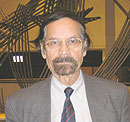|
Going Dutch: Indo-Surinamese in The Netherlands
|

|
|
|
In Europe besides the UK, the Netherlands is the second country with a substantial population of Indians. The Indo-Surinamese community, including Indians from India, number around 225,000. Indo- Surinamese call themselves Hindustanis and the majority of them came to the Netherlands during the early 1970s in a mass exodus. That’s when the political alliance between the Hindustanis and the Creoles collapsed and the Creole government unilaterally announced that November 25, 1975 would be the date of Surinamese independence.
In the minds of the Hindustanis, the Creole government was equated with the kind of oppression that people of Indian origin faced in neighbouring Guyana. Fearing the worst, thousands of Hindustanis migrated to the Netherlands, leaving their settled lives and homes in Surinam. The Hindustanis who were a majority in Surinam soon became a minority in the Netherlands.
|
| The forefathers of the PIOs dreamt of going back to India after their indenture contract but after settling in Surinam they postponed their departure |
|
In the Netherlands, the Hindustanis met other Indians who after the ban on immigration to the UK came in search of new economic avenues. This meeting did provide the Hindustanis some sort of support. But suddenly during the 1990s the government of India divided the Indian diaspora by coining two artificial terms and defined these Indian categories as NRIs, (non-resident Indians, immigrated after 26 January, 1950) and PIOs (the descendants of those Hindustanis who emigrated to the plantation colonies of British, French and Dutch governments after 1834 in order to save the plantation economy). The unexpected arrival of Hindustanis to the Netherlands is considered their second migration. The first emigration to Surinam started in 1873.
The stories of the emigration of their forefathers were around their recruitment—how they were trapped by the arkatis (recruiters), how they were brought by train to Calcutta, the boat trip to the main depot at the Garden Reach harbour, three months sailing to Surinam via Cape Town and St. Helena Islands and finally how they were sent to unknown plantations. In the plantations these workers lived in the same barracks as the slaves. In a way the Indians became part of the new system of slavery.
The forefathers of the PIOs always dreamt of going back to India after the termination of their five-year indenture contract but after settling in Surinam they always postponed their departure. It became a “myth of inspiration” which through oral stories became the source of maintaining their Indian identity.
Though there are cracks in the relationship between the Hindustanis and NRIs, the Indo-Surinamese Hindustani community is busy in developing a sense of unity as a single Indian group. The PIO community has become active in Dutch politics and has achieved higher government and institutional jobs. Their children feel integrated into the Dutch community and are proud of their Hindustani identity. In reality these children are the European leaders of tomorrow who will maintain on one side a bridge between Dutch and Indian cultures and on the other side a link with India and the NRI.
In order to maintain an internal Hindustani identity there are many associations, foundations and institutions working to enrich the knowledge to second generation Indians. These associations consist of secular, cultural, religious and sport organizations and institutions such as, SRS, Lallarookh, HIMOS, Ekta, Hindu Muslim religious organisations and Hindu Muslim private schools.
The Hindustanis are not only integrated with the Dutch community, they also participate in political decision making. They speak Dutch and their mother tongue, Sarnami or Sarnami Hindi. The Dutch government has given them a place in the media officially. There are two Dutch broadcasting corporations OHM (Hindu Broadcasting Corporation) and NMO (Netherlands Muslim Broadcasting) that use television and radio for maintaining their Indian (Hindustani) identity through religious, socio-cultural activities and events, such as the Milan festival and the Bollywood Film festival in the Hague.
The Indo-Surinamese Hindustanis want to see India become healthy and prosperous. Their dream is that the people of India must maintain unity in diversity. As they are the European Hindustanis they want to have a link with India rationally as well as emotionally. |
|
|
|
—The author teaches at the University of
Leiden, Netherlands |
|
|
|
|
|
January 2007
|
|

|
|
|
|